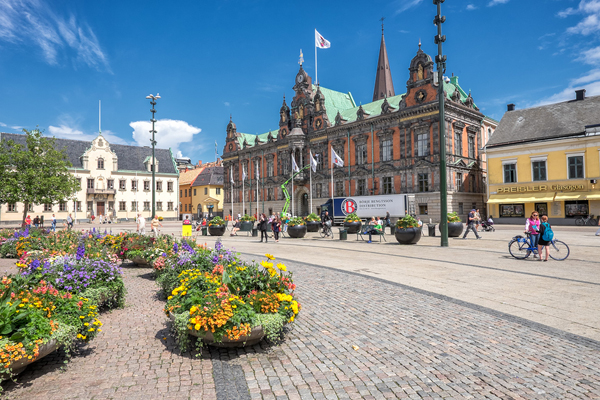Educational System in Sweden
Summary: The one tip that you hear expats living in Sweden repeatedly sharing with newcomers is not to buy a home when you first move to Sweden. Rent for a few months or longer so that you have time to find the right neighborhood. Give yourself time to ensure that Sweden is right for you for the long term. If you've already taken time to do those things and are ready to take the plunge and become a property owner, here are tips about buying a home in Sweden.

Sweden is renowned for its high-quality education system, which is free and compulsory for all children between the ages of 6 and 16. The system is designed to ensure equal opportunities for all students, regardless of their social or economic background. The Swedish education system is divided into several stages, each with its own focus and objectives. This guide will provide an overview of the main stages of education in Sweden, the enrollment process for newcomers, language learning support, the availability of bilingual and private schools, homeschooling and online schooling options, and the typical choices made by expats regarding their children's education.
What are the main stages of education in Sweden?
The Swedish education system is divided into three main stages: Förskola (Preschool), Grundskola (Compulsory School), and Gymnasium (Upper Secondary School). Preschool is for children aged 1 to 5 and focuses on play and creativity. Compulsory School is for children aged 6 to 16 and covers primary and lower secondary education. Upper Secondary School is for students aged 16 to 19 and offers both academic and vocational programs.
Förskola (Preschool)
Förskola, or preschool, is for children aged 1 to 5. It is not compulsory but is highly popular in Sweden. The focus at this stage is on play and creativity, with an emphasis on developing basic social and communication skills. The curriculum is flexible and child-centered, allowing children to learn at their own pace.
Grundskola (Compulsory School)
Grundskola, or compulsory school, is for children aged 6 to 16. It covers primary and lower secondary education. The curriculum is broad and balanced, covering subjects such as Swedish, English, mathematics, science, social studies, arts, and physical education. Students are assessed regularly, but there are no national exams until the end of this stage.
Gymnasium (Upper Secondary School)
Gymnasium, or upper secondary school, is for students aged 16 to 19. It offers both academic and vocational programs. Academic programs prepare students for higher education, while vocational programs provide skills for specific occupations. Both types of programs lead to a diploma, which is required for entry into higher education.
How does a newcomer from a different country enroll their kids in school?
Newcomers to Sweden can enroll their children in school by contacting the local municipality or the school directly. They will need to provide proof of residence, the child's birth certificate, and any previous school records. If the child does not speak Swedish, they are entitled to additional support in learning the language.
Can children still learning Swedish enroll in a public school?
Yes, children who are still learning Swedish can enroll in a public school. They are entitled to additional support in learning the language, which is usually provided in the form of Swedish as a Second Language (SVA) lessons. These lessons are designed to help students develop their Swedish language skills while also following the regular curriculum.
Are there public bilingual schools?
Yes, there are public bilingual schools in Sweden. These schools offer instruction in both Swedish and another language, such as English, French, or Spanish. Admission to these schools is usually based on language proficiency and availability of places. Some of these schools have a specific international focus and follow an international curriculum.
What types of private schools are common in Sweden?
Private schools in Sweden are diverse, ranging from international schools that follow an international curriculum to religious schools, Montessori schools, and Waldorf schools. International schools are popular among expats as they often offer instruction in English and follow a curriculum that is recognized worldwide.
Do expats typically send their children to public or private school?
Many expats in Sweden choose to send their children to public schools to immerse them in the local culture and language. However, international schools are also a popular choice, especially for families who are in Sweden for a short period or for those who prefer an English-speaking environment.
How expensive are Private schools in Sweden?
Private schools in Sweden can be quite expensive, with fees ranging from 50,000 to 100,000 SEK per year. However, some private schools are partially funded by the government and charge lower fees. It's important to check the fee structure of each school individually.
Are you allowed to homeschool while living in Sweden?
Homeschooling is not common in Sweden and is generally only allowed in exceptional circumstances, such as for children with special needs or for families who are temporarily living in Sweden. The decision to allow homeschooling is made by the local municipality.
May kids attend online school instead of a local school while living in Sweden?
Online schooling is not common in Sweden, and most children attend a local school. However, due to the COVID-19 pandemic, many schools have developed online learning capabilities. It's best to check with the local municipality or the school directly for the most accurate information.
About the Author
 Joshua Wood, LPC joined Expat Exchange in 2000 and serves as one of its Co-Presidents. He is also one of the Founders of Digital Nomad Exchange. Prior to Expat Exchange, Joshua worked for NBC Cable (MSNBC and CNBC
Primetime). Joshua has a BA from Syracuse and a Master's in Clinical and Counseling Psychology from Fairleigh Dickinson University. Mr. Wood is also a licensed counselor and psychotherapist.
Joshua Wood, LPC joined Expat Exchange in 2000 and serves as one of its Co-Presidents. He is also one of the Founders of Digital Nomad Exchange. Prior to Expat Exchange, Joshua worked for NBC Cable (MSNBC and CNBC
Primetime). Joshua has a BA from Syracuse and a Master's in Clinical and Counseling Psychology from Fairleigh Dickinson University. Mr. Wood is also a licensed counselor and psychotherapist.
Some of Joshua's articles include Pros and Cons of Living in Portugal, 10 Best Places to Live in Ireland and Pros and Cons of Living in Uruguay. Connect with Joshua on LinkedIn.
Additional Information:
- Sweden Guide
- Healthcare & Health Insurance in Sweden
- Members Talk about Healthcare & Health Insurance in Sweden
- Best Places to Live in Sweden
- Real Estate in Sweden
- Guide to Real Estate in Sweden
- Pros & Cons of Living in Sweden
- Cost of Living in Sweden
- 10 Things to Know Before Moving to Sweden
- How to Buy a Home in Sweden
- Pros and Cons of Living in Sweden
- How to Rent a Home in Sweden
- 2025 Guide to Living in Sweden
- Pros and Cons of Living in Sweden 2025
- 2025 Guide to Moving to Sweden




